Abstract
The aim of the present study was to propose a new and simple field assessment of inter-effort recovery and change of direction (COD) ability based on performance during the 30-15 Intermittent Fitness Test (30-15IFT, an intermittent, incremental shuttle-run test) using three different protocols. Forty team-sport players (22 ± 2 years) performed either (group A; n = 16) the original 30-15IFT and two modified versions, one without a rest period (i.e. continuous run, 30-15IFT-CONT) and one without COD (30-15IFT-LINE), or (group B; n = 24) the original 30-15IFT and a modified version with more COD (28-m shuttle instead of 40-m, 30- 15IFT-28m). Heart rate (HR), blood lactate concentration ([La]b), rating of perceived exertion (RPE) and maximal running speed were recorded for all tests. There was no statistical difference in either maximal HR (A: p = 0.07 and B: p = 0.94) or RPE (A: p = 0.10 and B: p = 0.97) between tests. Compared with the 30-15IFT (12.3 ± 2.5, p < 0.01) and 30-15IFT-LINE (11.3 ± 2.6, p = 0.07, ES = 0.61), [La]b was lower for 30-15IFT-CONT (9.6 ± 3.3 mmol.L-1). Compared with 30-15IFT, maximal running speed was higher for 30-15IFT-LINE (103.1 ± 1.7%, p < 0.001) and lower for 30-15IFT-CONT (93.2 ± 1.4%, p < 0.001), while it was similar for 30-15IFT-28m (99.7 ± 3.6%, p = 0.62). Maximal speeds reached after the four tests were significantly but not perfectly correlated (r = 0.74 to 95, all p < 0.001). Present results show that differences in the maximal running speed reached following different versions of the 30-15IFT can be used by coaches to isolate and evaluate inter- effort recovery (i.e. 30-15IFT vs. 30-15IFT-CONT) and COD (i.e., 30-15IFT vs. 30-15IFT-LINE) abilities in the field. Additionally, COD ability as evaluated here appears to be independent of shuttle-length.
Key points.
The comparison of the maximal running speed reached at the original 30-15IFT with these reached at two modified protocols (i.e., 30-15IFT-CONT and 30-15IFT-LINE ) enables a simple and field-based assess-ment of between-efforts recovery and COD abilities during high-intensity runs.
These data can be used by coaches to complete the physical profiling of each player, which could high-light the need for specific training interventions.
Keywords: High-intensity running, agility, intermittent exercise, field test, HR/speed relationship
Introduction
Competitive team-sports require players to repeatedly perform high- intensity runs (Ben Abdelkrim et al., 2007; Luig et al., 2008; Mohr et al., 2003; Sheppard et al., 2007), including frequent changes of direction (COD) (Brughelli et al., 2008). To assess such a team-sport specific cardiorespiratory fitness, the 30-15 Intermittent Fitness Test (30-15IFT; an intermittent, incremental shuttle-run test; Buchheit, 2008b) has recently been reported (e.g. Buchheit et al., 2009b; 2009c; Mosey, 2009) as a practical alternative to widely used incremental and continuous (Léger and Boucher, 1980; Léger and Lambert, 1982) or intermittent (e.g. Yo-Yo tests, Bangsbo et al., 2008) field tests. Similar to these “classical ”tests, the 30-15IFT elicits maximum heart rates (HR) and oxygen uptake (VO2) (Buchheit et al., 2009a), however, it also 1) evaluates inter-effort recovery, acceleration, deceleration and COD and 2) can be used for training prescription (Buchheit, 2008b). For instance, while the protocols of the different versions of the Yo-Yo test are obviously more team-sports specific than Léger’s tests (Bangsbo et al., 2008), the final performance measured (i.e., total distance covered) cannot be directly used for training prescription. Additionally, compared with the speed reached at the end of Léger’s field tests, the final running velocity reached at the end of the 30-15IFT (VIFT) has been shown to be more accurate for individualizing intermittent shuttle running exercise in team-sport players (Buchheit, 2008b). The 30-15IFT is also attractive since it has been perceived to be less “painful ”compared with continuous field tests by 70% of players assessed (Buchheit, 2005).
Recent studies (Buchheit, 2008a; 2008b; 2009a) have confirmed that VIFT can be considered as a ‘composite’ of several physical qualities determinant in team-sports. VIFT was shown to be well related to acceleration (inferred from a 10-m sprint time), jump height, maximum oxygen uptake, exercise autonomic control (inferred from heart rate variability measures during the test, Perandini et al., 2009), HR recovery (Buchheit, 2008b) and repeated-sprint ability (Buchheit, 2008a), while leading to greater blood acidosis than traditional field tests (Buchheit et al., 2009a). Nevertheless, while the evaluation of a ‘global team-sport specific fitness level’ is of great interest to monitor a team’s physical performance capacity throughout the competitive season (Bangsbo et al., 2008; Buchheit, 2008c), the assessment of a specific physical quality might also be sometimes required to target individualized training interventions (i.e., based on each player’s weaknesses/strengths). While numerous field tests can be used to selectively assess cardiorespiratory fitness, acceleration, speed, (explosive) strength of lower limbs and/or COD ability (see for example test batteries used in Mujika et al., 2009; Rampinini et al., 2007), there is no known method to isolate and assess inter-effort recovery ability in the field. Moreover, while COD ability is generally evaluated during brief and single exercise bouts (Brughelli et al., 2008), its assessment during high-intensity intermittent exercise, has not yet been evaluated. The evaluation of COD ability during runs at varying intensities is of great importance for coaches, since they likely determine the energetic cost of running during sport-specific displacements (Buchheit et al., 2011).
In the absence of a field-based and/or “gold standard ”measure of inter-effort recovery and COD ability during high-intensity exercise, we proposed to investigate a new and simple field-based assessment of these qualities with the use of the 30-15IFT.
Methods
Subjects
Forty regional-to-national level team-sport players (basketball, handball, futsal and soccer players) volunteered to participate in the study. Because of time constraints and players availability, some participants could not perform the entire test battery; they were then divided into two distinct experimental groups. Group A included 16 players (14 men; 22 ± 5 years, 75 ± 1 kg, 1.78 ± 0.02 m, body mass index 23.4 ± 1.4 kg·m-2 and 2 women; 20 ± 2 years, 65 ± 2 kg, 1. 72 ± 0.05 m, 22.1 ± 2.1 kg·m-2); Group B, 24 players (20 men; 24 ± 2 years, 82 ± 9 kg, 1.85 ± 0.06 m, 23.9 ± 1.8 kg·m-2 and 4 women: 21 ± 1 years, 67 ± 8 kg, 1.74 ± 0.07 m, 22.5 ± 1.6 kg·m-2). All players were provided with the procedures and risks associated with participation in the study and gave their written informed consent prior to participation. The study was approved by the local ethic committee and conformed to the Declaration of Helsinki.
Study design
To measure inter-effort recovery and COD ability during high-intensity exercise, we compared performance on the original 30-15IFT with that obtained with three modified protocols including either no rest period, no COD, or a greater number of COD. The protocols of the four different tests being similar with the exception of either the presence of recovery periods or the presence/number of COD, it is intuitive that the difference in running speed would be indirectly indicative of inter-efforts recovery and COD abilities. For group A, the experimental schedule comprised three consecutive testing sessions (Table 1), with all tests performed randomly 7 days apart: 1) the original 30-15IFT (40-m shuttle-run with 15 seconds recovery) 2) a continuous version (no rest/recovery period); 30-15IFT-CONT and 3) a straight-line version (no COD); 30-15IFT-LINE. For group B, the experimental schedule comprised two consecutive test sessions (Table 1), with all tests performed randomly 7 days apart: 1) the original 30-15IFT and 2) a modified version with a shorter (28-m) shuttle-length; 30-15IFT-28m. All players were well familiarized with the testing procedures in the weeks preceding the experimentation. Players were also asked to refrain from exercise in the 24h period preceding the tests. HR, blood lactate concentration ([La]b), rating of perceived exertion (RPE, 0-10 Borg scale) and maximal running speed were recorded for all tests.
Table 1.
Details of the field tests performed by the two experimental groups.
| Tests | ||
|---|---|---|
| Group A | 30-15 IFT | Original test (intermittent incremental shuttle (40-m) run test) |
| 30-15IFT-CONT | Similar to the 30-15IFT but with no rest periods, i.e., performed continuously (continuous incremental shuttle (40-m) run test) | |
| 30-15IFT-LINE | Similar to the 30-15IFT but without COD, i.e., performed on a 400-m track (intermittent incremental straight-line test) | |
| Group B | 30-15 IFT | Original test (intermittent, incremental shuttle (40-m) run test) |
| 30-15IFT-28m | Similar to the 30-15IFT but with more COD, i.e., performed on a shorter shuttle-length (intermittent incremental shuttle (28-m) run test) | |
Procedures
Original 30-15IFT. The 30-15IFT was performed as previously described (Buchheit, 2008b) on an indoor synthetic track where ambient temperature ranged from 18 to 22°C. Briefly, the 30- 15IFT consisted of 30-s shuttle-runs (40-m) interspersed with 15-s passive recovery periods. The initial running velocity was set at 8 km·h-1 for the first 30-s and speed increased by 0.5 km·h-1 every 30-s thereafter. Running pace was governed by a prerecorded audio signal. Subjects were instructed to complete as many (30-s) “stages ”as possible, and the test ended when the player could no longer maintain the required running speed (i.e. when players were unable to reach a 3-m zone near each marked line the moment the audio signalled on 3 consecutive occasions). The speed at the last completed stage (VIFT) has shown good reliability on two consecutive trials repeated 48h apart (intraclass correlation coefficient = 0.96; typical error = 0.33 (95% confidence limits, 0.26 - 0.46) km·h-1) (Buchheit, 2005).
Modified 30-15IFT without COD. The 30-15IFT-LINE was performed outdoors exactly as the 30- 15IFT (speed increments, recovery periods), but with no COD; the 30-s effort being therefore performed in straight-line (with cones placed every 20 m on a 400-m track). To avoid any potential confounding effects of excessive wind or changes in temperature, the test was only performed in clear and good weather conditions, i.e. when wind velocity ranged from -2.0 to +2.0 m·s-1 and temperature from 19 to 24°C.
Modified 30-15IFT without rest periods. The 30-15IFT-CONT was performed indoors exactly as the 30-15IFT (speed increments, shuttle-length), but without any rest periods.
Modified 30-15IFT with increased number of COD. The 30-15IFT-28m was performed indoors exactly as the 30-15IFT (speed increments, recovery periods), but with the length of the shuttle-run changed to 28m. This distance was chosen to induce a greater number of COD and corresponds to the length of a basketball field, which facilitates the implementation of the 30- 15IFT-28m in most gymnasia.
Estimation of inter-effort recovery ability. The only difference between the 30-15IFT-CONT and 30-15IFT protocols being the presence or not of a recovery period, it is intuitive that any difference in running performance between the tests is indirectly indicative of inter-effort recovery ability. Individual inter-efforts recovery ability was therefore estimated from the difference between the VIFT reached after the 30-15IFT and the 30-15IFT- CONT, with the greater the absolute difference in VIFT, the greater inter-effort recovery ability.
Estimation of COD abilities. The only difference between the 30-15IFT-LINE, 30-15IFT-28m and 30-15IFT protocols being the presence and/or the number of COD, it is intuitive that difference in running performance between the tests is indirectly indicative of COD abilities. Since there was no substantial difference in running performance for 30-15IFT-28m vs. 30-15IFT (see results), only data from the 30-15IFT were used to estimate COD abilities. Moreover, participants in Group B (who performed the 30-15IFT-28m) did not perform the 30-15IFT-LINE, so that this comparison could not be performed. Individual COD abilities was therefore estimated for Group A via the difference between the VIFT reached after the 30-15IFT and the 30-15IFT-LINE, with the lower absolute difference in VIFT indicating a better COD ability.
Measurements
Heart rate measurements. 5-s averaged HR was recorded using a Polar Team system (Polar Electro, Kempele, Finland). Average HR at 60, 70, 80, 90 and 100% of the final VIFT reached within each protocol was computed. The highest HR measured at the end of exercise was considered as HRpeak (b·min-1). Finally, the HR/running speed relationship (Boudet et al., 2004) was calculated for each protocol using the (individual) linear part of the relationship (i.e. between 60 to 80 % of VIFT), and was used as an indirect maker of the energetic cost of running during each test.
Blood lactate concentration. Three minutes after each test, a fingertip capillary blood sample (5 μL) was collected and analyzed for lactate concentration using a Lactate Pro lactate analyser (Arkray Inc, Kyoto, Japan) (Pyne et al., 2000). The accuracy of the analyzer was checked before each test session using supplied standards.
Statistical analysis
Since the women involved in the present study presented similar VIFT values compared with the men, and all analyses were based on within-subject changes, data from women and men were pooled. Data are presented as means and standard deviations (± SD). The distribution of each variable was examined using the Shapiro-Wilk normality test and homogeneity of variance was verified with a Levene test. When data were skewed, they were transformed by taking the natural logarithm to allow parametric statistical comparisons that assume a normal distribution (for clarity, however, all data are presented as back-transformed). For each group separately, VIFT, HRpeak, [La]b and RPE data were analyzed using a one-way (i.e. test) ANOVA for repeated measures. HR data during exercise were analyzed using a two-way ANOVA for repeated measures, with ‘intensity’ and ‘test’ as factors. When a significant interaction was noted, Bonferroni’s post-hoc tests were conducted. The correlation coefficient (i.e. Pearson’s r) with 90% confidence limits (CL) were also calculated to examine the relationships between the VIFT reached after each test. In addition to statistical significance, the following criteria were adopted for interpreting the magnitude of the correlation (r): < 0.1, trivial; >0.1-0.3, small; >0.3-0.5, moderate; >0.5-0.7, large; >0.7-0.9, very large; and >0.9-1.0, almost perfect. If the 90% confidence limits overlapped positive and negative values (i.e. included zero), the magnitude was deemed unclear (Hopkins et al., 2009). Statistical analyses were performed using SigmaStat software (SigmaStat 3.11, Systat software Inc., San Jose, CA, USA). The level of significance was set at p < 0.05. Between-protocol standardized differences (i.e. effect size or Cohen’s d) were also calculated (Cohen, 1988) when a tendency toward significance was noted (p < 0.10). The magnitude of the difference was considered either trivial (Cohen’s d < 0.2), small (>0.2-0.5), moderate (>0.5-0.8), or large (>0.8). Normative values used to qualitatively assess inter-effort recovery and COD ability were also calculated using Cohen’s d principle. The between-subject SD of the differences in VIFT between two tests (e.g. 30-15IFT-LINE vs. 30-15IFT) was multiplied by 0.2, 0.5 and 0.8 to derive values regarded as slightly (small), moderately or largely better or worse than the average value (Hopkins et al., 2009) for the sample of players investigated.
Results
All measures were available for Group A. In Group B, due to technical problems and poor quality of the HR signal, HRpeak was only obtained from 20 (83%) players and the relation HR/running speed was only assessed in 17 (71%) participants. [La]b was also only obtained from 19 (79%) participants. Data for VIFT, HRpeak, [La]b and RPE obtained for each protocol are presented in Table 2, while VIFT reached with each protocol, expressed as a percentage of the speed reached with the original 30-15IFT is illustrated in Figure 1.
Table 2.
Selected physiological responses and maximal running speed reached at the end of the different 30-15IFT protocols. Data are means (±SD).
| Group A | Group B | ||||
|---|---|---|---|---|---|
| 30-15IFT | 30-15IFT-LINE | 30-15IFT-CONT | 30-15IFT | 30-15IFT-28m | |
| VIFT (km·h-1) | 19.7 (1.2) | 21.7 (1.9) * | 16.1 (1.0) *† | 18.8 (2.1) | 18.7 (1.8) |
| HRpeak(b·min-1) | 197 (10) | 197 (7) | 194 (8) | 198 (9) | 199 (9) |
| HR/speed | 3.9 (.8) | 3.4 (.6) | 5.8 (1.1) *† | 4.2 (1.0) | 3.9 (.8) § |
| [La]b (mmol·L-1) | 12.3 (2.5) | 11.3 (2.6) | 9.6 (3.2) *‡ | 11.3 (2.1) | 11.5 (2.8) |
| RPE | 9 (1) | 9 (1) | 8 (1) | 8 (1) | 8 (1) |
VIFT : maximal running speed, HRpeak : peak heart rate, [La]b: blood lactate concentration, RPE : rating of perceived exertion, 30-15IFT : original 30-15IFT, 30-15IFT-CONT : modified version of the 30-15IFT without a rest period, 30-15IFT-LINE : modified version of the 30-15IFT without change of direction, 30-15IFT-28m : modified version of the 30-15IFT with 28-m shuttles.
*: difference vs. 30-15IFT (p < 0.05)
†: difference vs. 30-15IFT-LINE (p < 0.05)
‡: difference vs. 30-15IFT-LINE with effect size considered as moderate (>0.5)
§: difference vs. 30-15IFT-LINE with effect size considered as small (0.2<ES≤0.5)
Figure 1.
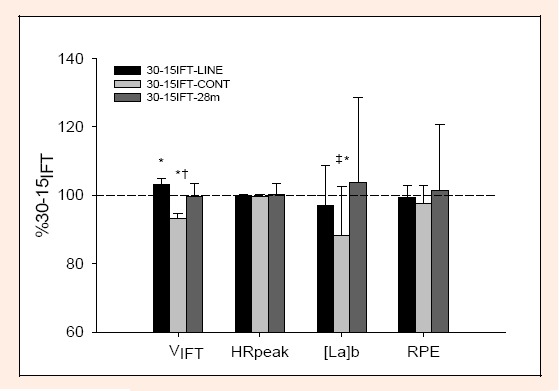
Maximal running speed (VIFT), peak heart rate (HRpeak), blood lactate ([La]b) and rating of perceived exertion (RPE) reached with each protocol, expressed as a percentage of the values reached at the end of the original 30-15IFT. *: p < 0.05 vs. 30-15IFT, †: p < 0.05 vs. 30-15IFT-LINE, ‡: difference vs. 30-15IFT-LINE with effect size considered as moderate (>0.5)
Maximal running velocity
In Group A, VIFT (km·h-1) was higher for 30-15IFT-LINE (p < 0.001) and lower for 30-15IFT-CONT (p < 0.001) compared with the original 30-15IFT. In Group B, there was no difference between VIFT for 30-15IFT and 30-15IFT-28m (p = 0.62) (Table 2 and Figure 1). In Group A there was a very large and significant correlation between VIFT reached during 30-15IFT vs. 30-15IFT-LINE (r = 0.82 (90% confidence limits (CL) 0.62; 0.93), p < 0.001). Similarly there was a very large and significant correlation between VIFT reached during 30-15IFT vs. 30-15IFT-CONT (r = 0.74 (0.47; 0.89), p < 0.001). In Group B, the correlation between maximal speeds reached during 30-15IFT and 30-15IFT-28m was almost perfect (r = 0.95 (0.91; 0.98), p < 0.001) (Figure 2).
Figure 2.
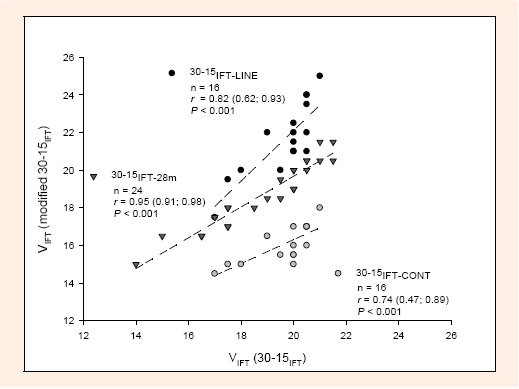
Relationship between maximal velocity (VIFT) reached at the end of the traditional 30-15IFT vs. modified versions of the 30-15IFT (i.e., 30-15IFT-CONT: without resting period [gray circles], 30-15IFT-LINE: without changes of direction [black cir-cles], 30-15IFT-28m: with 28-m shuttles [dark gray triangles])
Peak HR and HR /running velocity relationship
As illustrated in Table 2 and Figure 1, there was no difference for HRpeak between the three different 30-15IFT tests in either Group A (ANOVA main effect p = 0.07) or B (p = 0.94). There was a significant ‘test’ (p < 0.001) and ‘intensity’ (p < 0.001) effect for HR at 60, 70, 80, 90 and 100% of the final VIFT of each protocol, as well as an ‘intensity x test’ interaction (p < 0.001).
In Group A, HR increased significantly during exercise with 60<70<80<90=100% for 30-15IFT, 30-15IFT-LINE and 30-15IFT-CONT. In Group B, HR increased similarly during both 30-15IFT and 30-15IFT-28m (60<70<80<90<100%, p < 0.05) (Figure 3). When compared with HR during 30-15IFT-CONT, HR was lower at 60, 70 and 80% during 30-15IFT (p < 0.05) and at 60 and 70% during 30-15IFT-LINE (p < 0.05).
Figure 3.
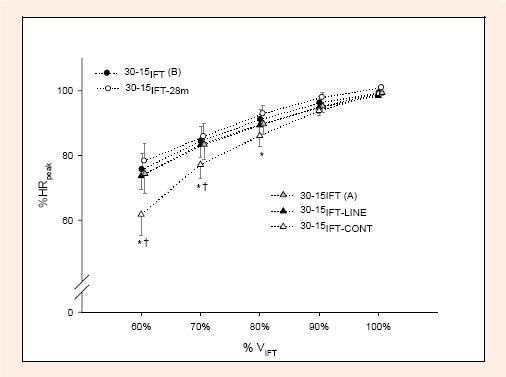
Evolution of heart rate (HR, expressed as a percentage of peak heart rate (HRpeak) reached during the original 30-15IFT) for Group A and B as a function of relative exercise intensity during the four protocols (30-15IFT : original 30-15IFT, 30-15IFT-CONT : modified version of the 30-15IFT without resting periods, 30-15IFT-LINE : modified version of the 30-15IFT without changes of direction, 30-15IFT-28m : modified version of the 30-15IFT with 28-m shuttles.) *: p < 0.05 vs. 30-15IFT (A), †: p < 0.05 vs. 30-15IFT-LINE
The HR/speed relationship was higher in 30-15IFT-CONT compared with 30-15IFT (p < 0.001) and 30-15IFT-LINE (p < 0.001). A tendency toward a higher HR/running speed relationship was noted for 30-15IFT vs. 30-15IFT-28m (p = 0.05, Cohen’s d =0.39)
Blood lactate concentration
The [La]b was lower for 30-15IFT-CONT compared with 30-15IFT (p < 0.01) and tended to be lower compared with 30-15IFT-LINE (p = 0.07, Cohen’s d =0.61). There was no difference in [La]b between 30-15IFT vs. 30-15IFT-28m (p = 0.88) (Table 2).
Rating of perceived exertion
For Group A there was no difference in RPE between all testing conditions (ANOVA main effect, p = 0.10). Similarly, there was no significant difference in RPE between 30-15IFT vs. 30-15IFT-28m in Group B (p = 0.97) (Table 2).
Inter-effort recovery and COD ability
The mean absolute VIFT difference between 30-15IFT and 30-15IFT-CONT was 3.6 ± 0.8 km·h-1 and values for slightly, moderately and largely better/worse inter-effort recovery ability compared with the mean were ± 0.2, ± 0.4 and ± 0.6 km·h-1. Regarding COD ability, the mean absolute VIFT difference between 30-15IFT and 30-15IFT-LINE was 2.0 ± 1.2 km·h-1. Values for slightly, moderately and largely better/worse COD ability compared with the mean were ± 0.2, ± 0.6 and ± 0.9 km·h-1. To increase the generalization of the present findings (e.g. to players recording different absolute VIFT values) and make the assessment of inter-effort recovery and COD ability more understandable, a visual scale was produced (Figure 4; with all values expressed as a percentage of VIFT).
Figure 4.
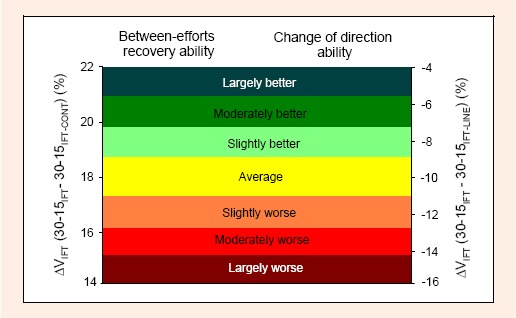
Scale to assess between-efforts recovery (left) and change of direction (right) abilities during high-intensity intermittent runs, derived from between-tests differences in maximal running speed (VIFT). 30-15IFT : original 30-15IFT, 30-15IFT-CONT : modified version of the 30-15IFT without resting period, 30-15IFT-LINE : modified version of the 30-15IFT without changes of direction. See methods for thresholds calculations.
Discussion
In an attempt to propose a novel and simple field-based assessment of inter-effort recovery and COD ability during high-intensity running exercise, we compared performance and selected physiological responses to the original 30-15IFT with those obtained with three modified protocols including either no rest period, no COD, or more COD. The main findings of the present study were as follows: 1) the mean absolute difference in VIFT between 30-15IFT and 30-15IFT-CONT was 3.6 ± 0.8 km·h-1; between 30-15IFT and 30-15IFT-LINE was 2.0 ± 1.2 km·h-1 and between 30-15IFT and 30-15IFT-28m was 0.1 ± 0.6 km·h-1, and 2) while there was an almost perfect correlation between maximal speeds reached during 30-15IFT and 30-15IFT-28m (r = 0.95), the relationships for 30-15IFT vs. 30-15IFT-CONT (r = 0.74) and 30-15IFT vs. 30-15IFT-LINE (r = 0.82) were only large.
Maximal nature of the test and study design
The examination of inter-effort recovery and COD ability during high-intensity exercise can only be accurate with tests performed to exhaustion. The present data show that all tests could be considered as maximal, as evidence by attainment of (similar) peak HRs, blood lactate concentrations (above > 9 mmol.L-1) and RPE (values > 8). The fact that all tests were not completed by the same cohort is, however, a limitation of the present study, but since we found no significant difference between the tests performed over 28- or 40-m (Group B), all calculations to assess inter-effort recovery and COD ability were finally performed on the same players (Group A).
Assessment of inter-effort recovery ability during high-intensity exercise
In the absence of a field-based measure of inter-effort recovery ability during high-intensity exercise, we proposed to examine the difference in performance on the 30-15IFT vs. the 30-15IFT-CONT. As expected, the removal of a recovery period led to poorer performance (i.e. slower VIFT with a mean difference of 3.6 ± 0.8 km·h-1). While partial phosphocreatine (PCr) stores replenishment may be possible during each 15-s recovery periods during the 30-15IFT (Glaister, 2005), this could not occur during the continuous test (30-15IFT-CONT). As expected, compared with the original 30-15IFT, the energetic demand increased faster during 30-15IFT-CONT (as evidence by the greater HR/running speed slope, Figure 3), which likely precipitated earlier development of fatigue and exercise cessation. The lower speed reached during 30-15IFT-CONT was also likely responsible for the lower peak blood lactate values. The collection of RPE data at the end of each stage during the 30-15IFT and at similar time points during 30-15IFT-CONT could have also helped to further understand the cause of the premature exercise cessation during the 30-15IFT-CONT (Tucker, 2009). It is, however, worth noting that 30-15IFT-CONT explained only 54% of the variance of 30-15IFT (Figure 2), suggesting that individual differences in recovery ability might partly account for the different VIFT observed in players presenting similar performance in the 30-15IFT-CONT. The important SD for the mean difference between running speeds 30-15IFT vs. 30-15IFT-CONT (i.e. 0.8 km·h-1) also confirms this inter-individual variability in the response to recovery periods.
Based on this line of thinking, in moderately-trained team-sport players (at least for those showing similar characteristics to the participants of the present study), an absolute 30-15IFT vs. 30-15IFT-CONT difference greater than 4 km·h-1 (>20%) might be indicative of a “good ”(i.e. at least ‘large’, based on Cohen’s d) inter-effort recovery ability; conversely, a 30-15IFT vs. 30-15IFT-CONT difference smaller than 3 km.h-1 (<15%) might reflect a “poor ”recovery ability (Figure 4). For example, in the present study, three players (20%) with likely “good ”inter-effort recovery ability presented a difference in running speed of 4.5 km·h- 1, while three others with likely “poor ”inter-effort recovery ability have a difference of 2.5 km·h-1. Future studies investigating physiological variables such as neuromuscular adjustments (i.e. changes in voluntary maximal or sustained force-generating capacity) (Perrey et al., 2010), changes in ATP/PCr muscle content, muscle buffer capacity (Glaister, 2008) and/or muscle oxygenation levels (Dupont et al., 2004) during both 30-15IFT and 30-15IFT-CONT tests might help to improve our understanding of the determinants of inter-effort recovery ability during high-intensity intermittent exercise.
Assessment of changes of direction ability during high-intensity exercise
While COD ability is generally evaluated during brief and single exercise bouts (Brughelli et al., 2008), its assessment during high-intensity intermittent exercise has not yet been investigated. More importantly, there is currently no ‘gold standard’ test to assess COD (Brughelli et al., 2008). To suggest a simple means of evaluating COD ability during high-intensity exercise, we investigated the effect on VIFT of removing (30-15IFT-LINE) or increasing the number of CODs (30-15IFT-28m). Not surprisingly, and in agreement with previous findings during incremental continuous tests (Ahmaidi et al., 1992; Buchheit et al., 2011), a faster final speed was reached without COD (exemplified by the absolute 2.0 ± 1.2 km.h-1 difference between VIFT reached during 30-15IFT and 30-15IFT-LINE).
Despite a non significant change in the HR/speed relationship (Table 2 and Figure 3), it is possible that deceleration, COD and acceleration phases during the original 30-15IFT were responsible for a greater energetic demand compared with the 30-15IFT-LINE (Osgnach et al., 2010), which, in turn, precipitated earlier exercise cessation (Buchheit et al., 2011). In comparison with the 30-15IFT-LINE, the reduction in VIFT during the 30-15IFT could also be related to non-metabolic factors such as muscle structure alteration (because of the eccentric work inherent in deceleration phases) or psychological factors (Tucker, 2009). Performance during the 30- 15IFT-LINE explained only 67% of the variance of that attained during the 30-15IFT (Figure 2), which was suggestive of inter-individual differences in COD abilities. The important SD for the mean difference between running speeds during the 30- 15IFT vs. the 30-15IFT-LINE (i.e. 1.2 km·h-1) confirmed this inter-individual variability in the response to COD.
Interestingly, increasing COD (30-15IFT-28m) neither affected VIFT nor the HR/speed relationship (Table 2 and Figure 3), and both VIFT values were almost perfectly correlated (Figure 2, with 90% of shared variance). The fact that players who performed well on 40-m shuttle-run also performed well using 28-m shows that COD ability may be independent of shuttle-length. Whether COD can be considered as a general quality (Clarke and Clarke, 1970) has still to be examined using other COD angles and/or shuttle-lengths. It can, however, be suggested that players displaying an absolute 30-15IFT vs. 30-15IFT-LINE difference greater than 3 km·h-1 (>15%) might present a “poor ”(i.e. largely worse than the average) COD ability; conversely, an absolute 30-15IFT vs. 30-15IFT-LINE difference lower than 1 km·h-1 (<6%) might be indicative of a “good ”COD ability (Figure 4). For example, in the present study, three players with likely “good ”COD ability (20%) presented a difference in running speed of 0.5 km.h-1, while another with likely “poor ”COD ability have a difference of 4 km·h-1.
Finally, it is also worth noting that blood lactate concentration was unaffected by either the presence or the number of COD (blood lactate values were similar for the three tests considered here). While this contrasts with previous studies which reported higher blood lactate values after shuttle- compared with straight- line runs (Ahmaidi et al., 1992; Dellal et al., 2010), it is possible that compared with the 30-15IFT-LINE, the lower running speed during the 30-15IFT compensated for the possibly greater anaerobic system participation that generally occurs when running with COD, leading, in turn, to similar blood lactate values. Similarly, the lack of difference in blood lactate concentrations between 30-15IFT and 30-15IFT-28m is likely related to the similar running speed reached at the end of both tests (Table 2). Again, future studies examining RPE and/or blood lactate concentration at the end of each stage might help gain insight into the mechanisms underlying premature exercise cessation with COD tests.
Conclusion
To conclude, our findings in moderately-trained team sport players show that inter-effort recovery and COD ability during high- intensity intermittent shuttle-runs show high inter-individual variability (as inferred from the SD of the mean differences between running performance on the different tests and the spread of the correlations between the tests results), and might therefore explain differences in high-intensity intermittent endurance capacity among athletes with similar levels of cardiorespiratory fitness. The comparison of the maximal running speed reached during the original 30-15IFT with those reached during two modified protocols (30-15IFT-CONT and 30-15IFT-LINE) may enable a simple field-based assessment of between-efforts recovery and COD ability during high-intensity shuttle-runs. Such data can be used by coaches to complete the physical profiling of a player, which could highlight the need for potential inter-effort recovery or COD ability-oriented training interventions. Further studies in populations differing in inter-effort recovery and COD ability (i.e. as a function of age and/or training status) are still required to evaluate the sensitivity of the present method.
Acknowledgments
The authors thank the subjects for their enthusiastic participation.
Biographies
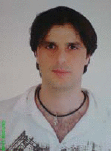
Bachar Haydar
Employment
“Laboratory of Exercise Physiology and Rehabilitation”, EA 3300, Faculty of Sport Sciences, University of Picardie, Jules Verne, 80025, Amiens, France.
Degree
MSc
Research interests
Determinants of changes of direction abilities
E-mail: bachar.haydar@hotmail.fr

Hani Al Haddad
Employment
“Laboratory of Exercise Physiology and Rehabilitation”, EA 3300, Faculty of Sport Sciences, University of Picardie, Jules Verne, 80025, Amiens, France.
- Physiology Unit, Sport Science Department, ASPIRE, Academy for Sports Excellence, Doha, Qatar.
Degree
MSc
Research interests
Heart rate variability and determinants of high-intensity running performance in team-sports
E-mail: alhaddad.hani@gmail.com

Said Ahmaidi
Employment
“Laboratory of Exercise Physiology and Rehabilitation”, EA-3300, Faculty of Sport Sciences, University of Picardie, Jules Verne, 80025, Amiens, France.
Degree
PhD
Research interests
Exercise Physiology and Rehabilitation
E-mail: said.ahmaidi@u-picardie.fr

Martin Buchheit
Employment
- “Laboratory of Exercise Physiology and Rehabilitation”, Faculty of Sport Sciences, University of Picardie, Jules Verne, Amiens, France.
- Physiology Unit, Sport Science Department, ASPIRE, Academy for Sports Excellence, Doha, Qatar.
Degree
PhD
Research interests
Determinants of high-intensity running performance in team-sports and heart rate variability
E-mail: martin.buchheit@u-picardie.fr
References
- Ahmaidi S., Collomp K., Prefaut C. (1992) The effect of shuttle test protocol and the resulting lactacidaemia on maximal velocity and maximal oxygen uptake during the shuttle exercise test. European Journal of Applied Physiology 65, 475-479 [DOI] [PubMed] [Google Scholar]
- Bangsbo J., Iaia F.M., Krustrup P. (2008) The Yo-Yo intermittent recovery test: a useful tool for evaluation of physical performance in intermittent sports. Sports Medicine 38, 37-51 [DOI] [PubMed] [Google Scholar]
- Ben Abdelkrim N., El Fazaa S., El Ati J. (2007) Time-motion analysis and physiological data of elite under-19-year-old basketball players during competition. British Journal of Sports Medicine 41, 69-75 [DOI] [PMC free article] [PubMed] [Google Scholar]
- Boudet G., Albuisson E., Bedu M., Chamoux A. (2004) Heart rate running speed relationships-during exhaustive bouts in the laboratory. Canadian Journal of Applied Physiology 29, 731-742 [DOI] [PubMed] [Google Scholar]
- Brughelli M., Cronin J., Levin G., Chaouachi A. (2008) Understanding change of direction ability in sport: a review of resistance training studies. Sports Medicine 38, 1045-1063 [DOI] [PubMed] [Google Scholar]
- Buchheit M. (2005) [The 30-15 Intermittent Fitness Test: a new intermittent running field test for intermittent sport players - Part 1]. Approches du Handball 87, 27-34 [Google Scholar]
- Buchheit M. (2008a) 30-15 Intermittent Fitness Test and repeated sprint ability. Science & Sports 23, 26-28 [Google Scholar]
- Buchheit M. (2008b) The 30-15 Intermittent Fitness Test: accuracy for individualizing interval training of young intermittent sport players. Journal of Strength and Conditioning Research 22, 365-374 [DOI] [PubMed] [Google Scholar]
- Buchheit M. (2008c) Field tests to monitor athletic performance throughout a team-sport season. Science & Sports 23, 29-31 [Google Scholar]
- Buchheit M., Al Haddad H., Leprêtre P.M., Millet G., Newton M., Ahmaidi S. (2009a) Cardiorespiratory and cardiac autonomic responses to 30-15 Intermittent fitness test. Journal of Strength and Conditioning Research 23, 93-100 [DOI] [PubMed] [Google Scholar]
- Buchheit M., Haydar B., Hader K., Ufland P, Ahmaidi S. (2011). Assessing running economy during field running with changes of direction: application to 20-m shuttle-runs. International Journal of Sports Physiology and Performance. In Press. [DOI] [PubMed]
- Buchheit M, Laursen P.B, Kuhnle J., Ruch D., Renaud C., Ahmaidi S. (2009b) Game-based training in young elite handball players. International Journal of Sport Medicine 30: 251-258 [DOI] [PubMed] [Google Scholar]
- Buchheit M., Laursen P.B., Millet G.P., Pactat F., Ahmaidi S. (2007) Predicting Intermittent Running Performance: Critical Velocity vs. Endurance Index. International Journal of Sport Medicine 29, 307-315 [DOI] [PubMed] [Google Scholar]
- Buchheit M., Lepretre P.M., Behaegel AL., Millet G.P., Cuvelier G., Ahmaidi S. (2009c) Cardiorespiratory responses during running and sport-specific exercises in handball players. Journal of Science in Medicine and Sport 12, 399-405 [DOI] [PubMed] [Google Scholar]
- Clarke D, Clarke H. (1970) Research processes in physical education, recreation and health. Engelwood Cliffs, N.J., Prentice-Hall [Google Scholar]
- Cohen J. (1988) Statistical Power Analysis for the Behavioral Sciences. Hillsdale, Lawrence Erlbaum [Google Scholar]
- Dellal A., Keller D., Carling C., Chaouachi A., Wong D.P., Chamari K. (2010) Physiologic effects of directional changes in intermittent exercise in soccer players. Journal of Strength and Conditioning Research 24, 3219-3226 [DOI] [PubMed] [Google Scholar]
- Dupont G., Moalla W., Guinhouya C., Ahmaidi S., Berthoin S. (2004) Passive vs. active recovery during high-intensity intermittent exercises. Medicine and Science in Sports and Exercise 36, 302-308 [DOI] [PubMed] [Google Scholar]
- Glaister M. (2005) Multiple sprint work: physiological responses, mechanisms of fatigue and the influence of aerobic fitness. Sports Medicine 35, 757-777 [DOI] [PubMed] [Google Scholar]
- Glaister M. (2008) Multiple-sprint work: methodological, physiological, and experimental issues. International Journal of Sports Physiology and Performance 3, 107-112 [DOI] [PubMed] [Google Scholar]
- Hopkins W.G., Marshall S.W., Batterham A.M., Hanin J. (2009) Progressive statistics for studies in sports medicine and exercise science. Medicine and Science in Sports and Exercise 41, 3-13 [DOI] [PubMed] [Google Scholar]
- Léger LA., Boucher R. (1980) An indirect continuous running multistage field test: the Universite de Montreal track test. Canadian Journal of Applied Sport Sciences 5, 77-84 [PubMed] [Google Scholar]
- Léger LA., Lambert J. (1982) A maximal multistage 20-m shuttle run test to predict VO2 max. European Journal of Applied and Occupational Physiology 49, 1-12 [DOI] [PubMed] [Google Scholar]
- Luig P., Manchado Lopez C., Pers J., Perse M., Kristan M., Schander I., Zimmermann M., Henke T., Platen P. (2008) Motion characteristics according to playing position in international men’s team handball. : Abstract Book of 13th Annual Congress of the European College of Sport Science, 9-12 July, Estoril, Portugal; 241 [Google Scholar]
- Midgley A.W., McNaughton L.R., Carroll S. (2007) Physiological determinants of time to exhaustion during intermittent treadmill running at VO2max. International Journal of Sport Medicine 28, 273-280 [DOI] [PubMed] [Google Scholar]
- Mohr M., Krustrup P., Bangsbo J. (2003) Match performance of high-standard soccer players with special reference to development of fatigue. Journal of Sports Sciences 21, 519-528 [DOI] [PubMed] [Google Scholar]
- Mosey T. (2009) High intensity interval training in youth soccer players - using fitness testing results practically. Journal of Australian Strength and Conditioning 17, 49-51 [Google Scholar]
- Mujika I., Santisteban J., Impellizzeri F.M., Castagna C. (2009) Fitness determinants of success in men’s and women’s football. Journal of Sports Sciences 27, 107-114 [DOI] [PubMed] [Google Scholar]
- Osgnach C., Poser S., Bernardini R., Rinaldo R., di Prampero P.E. (2010) Energy cost and metabolic power in elite soccer: a new match analysis approach. Medicine and Science in Sports and Exercise 42, 170-178 [DOI] [PubMed] [Google Scholar]
- Perandini L.A.B., Chimin N., Okuno J., Lima J.R.P., Buchheit M., Nakamura F. (2009) Parasympathetic withdrawal during 30-15 intermittent fitness test correlates with its’ maximal running speed in male handball players. Journal of Exercise Physiology-online 12, 29-39 [Google Scholar]
- Perrey S., Racinais S., Saimouaa K., Girard O. (2010) Neural and muscular adjustments following repeated running sprints. European Journal of Applied Physiology 109, 1027-1036 [DOI] [PubMed] [Google Scholar]
- Pyne D.B., Boston T., Martin D.T., Logan A. (2000) Evaluation of the Lactate Pro blood lactate analyser. European Journal of Applied Physiology 82, 112-116 [DOI] [PubMed] [Google Scholar]
- Rampinini E., Bishop D., Marcora S.M., Ferrari Bravo D., Sassi R., Impellizzeri F.M. (2007) Validity of simple field tests as indicators of match-related physical performance in top-level professional soccer players. International Journal of Sport Medicine 28, 228-235 [DOI] [PubMed] [Google Scholar]
- Sheppard J.M., Gabbett T., Taylor K.L., Dorman J., Lebedew A.J., Borgeaud R. (2007) Development of a repeated-effort test for elite men’s volleyball. International Journal of Sports Physiology and Performance 2, 292-304 [DOI] [PubMed] [Google Scholar]
- Tucker R. (2009) The anticipatory regulation of performance: the physiological basis for pacing strategies and the development of a perception-based model for exercise performance. British Journal of Sports Medicine 43, 392-400 [DOI] [PubMed] [Google Scholar]


